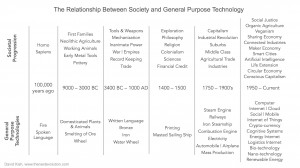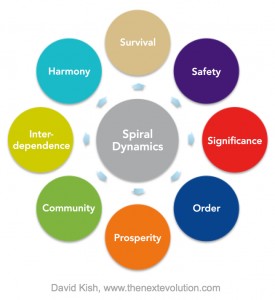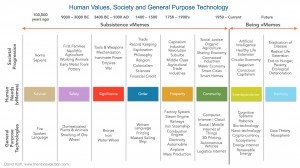Today, leaders must carve a path through unprecedented disruption resulting from the digital revolution. New technologies, innovations and business models are emerging so rapidly that many leaders are at a loss for how to proceed. In this post, I’ll offer a heuristic to make sense of the disruptions and predict where things will go next. As with any heuristic, my intent is to help leaders make strategy decisions quickly and position their organizations to adapt in this time of uncertainty. To do this, I’ll explore the history of technology change and offer a framework for understanding why those changes occurred when they did. I’ll then use the framework to understand the innovations emerging today and present key implications for future business strategies.
Are We in the Most Transformative Period in History?
Historian Ian Morris said that the industrial revolutions made a mockery of all that came before them with the unprecedented impact they had on global social development. The inventions of steam power, railways, oil, interstate highways, electricity, combustion engine and telephone combined to create a general purpose technology platform, which spurred innovation and propelled the human race forward. In his work on artificial intelligence, MIT Director of Center for Digital Business Andrew McAfee wondered whether the current digital revolution is more transformative than the industrial revolutions. To answer that question, McAfee looked at Ian Morris’ social development index (SDI) to determine what historical developments have had the greatest impact. He concluded, like Morris, that the technologies of the industrial revolutions propelled the human race forward, while such developments as empires, religions, philosophies, mathematics, exploration and the renaissance had little to no impact at all. If the industrial revolutions, which infinitely multiplied the power of our individual muscles, were historically most transformative, then he surmised that the digital revolution, which is infinitely multiplying the power of our individual minds, must be at least as transformative.

While this conclusion is fascinating, I couldn’t help but wonder what the SDI measures and how it could lead one to conclude that some of the most profound developments in human history were essentially meaningless in terms of human progress. I’ll address that topic in a future post, but for now, I’ll look more closely at the history of general purpose technologies (GPTs) and social development to find patterns that could be helpful in predicting the future.
The Mother of Invention
The graphic below (click to enlarge) depicts the relationship between GPTs and social development. Starting about 100,000 years ago, the emergence of Homo Sapiens was greatly enabled by the invention of fire and spoken language. From approximately 9000 BC, the domestication of plants and animals; smelting of ore and creation of the wheel led directly to neolithic agriculture, the creation of tools and pottery and the proliferation of families. From about 3400 BC, the emergence of written language, the water wheel and the use of bronze and iron enabled humans to keep records and trade; develop better tools and weapons; develop mechanical systems and make war. In the 1400-1500 timeframe, the invention of printing and the masted sailing ship facilitated the age of exploration and proliferation of philosophy and religion. Inventions of the late 1700’s to 1900’s, which included the steam engine, railways, combustion engine and electricity brought about the industrial revolutions. Lastly, today’s digital technologies are converging to enable the disruptive scenarios that are currently emerging.

One can see that for each GPT, there were significant advances in social development. So, why did we invent these GPT’s when we did? I thought of the old saying that “necessity is the mother of invention” and wondered if an understanding of human needs could explain the progressions of GPT and social development. That led me to the work of psychologist Clare Graves.
Graves developed a theory of human evolution in the 60’s and 70’s, which stated that the psychology of human beings transitioned throughout time based upon an ever increasingly set of complex life conditions. Graves classified eight expressions of increasingly complex value systems (or vMemes) that consisted of world views, preferences, and purposes. Groups structure their societies through these value systems and individuals integrate within them. Each successive value system is developed to solve the problems of the previous value system. His theory was further developed by prodigies Don Beck and Chris Cowan into a structured evolutionary model of adaptive intelligence called Spiral Dynamics.
Below is a brief overview of the Spiral Dynamics model. A more detailed description of the model can be found here. The first tier, which is comprised of the first six value systems is referred to as the subsistence tier because each of its vMEMEs represent a singular world view. The second tier is referred to as the Being tier because it places value on the co-existence of all vMEMEs in an information rich, highly mobile “global village”. Graves referred to the second tier as the time when humans would make a momentous leap in values.

1st Tier Subsistence vMEMEs
Beige “Survival” vMEME
The Beige “Survival” vMEME appeared 100,000+ years ago. In this vMEME, an individual uses instincts and habits just to survive.
Purple “Safety” vMEME
The Purple “Safety” vMEME occurred about 50,000 years ago and values allegiance to chief, elders, ancestors and the clan. It preserves sacred objects, places, events, and stories.
Red “Significance” vMEME
The Red “Significance” vMEME occurred about 10,000 years ago. In this vMEME where the world is seen as a jungle full of threats and predators, the individual pleases oneself, demands respect and dominates other aggressive characters.
Blue “Order” vMEME
The Blue “Order” vMEME began about 5,000 years ago and values sacrificing oneself to the transcendent cause, truth, or righteous pathway. There is one right way to live and deviations from the path are punished.
Orange “Prosperity” vMEME
The Orange “Prosperity” vMEME began 300 years ago and values legal freedoms, capitalistic democracies and strong faith in science and rationality. It seeks to live the “good life” and believes that risk-taking and self-reliant people deserve their success.
Green “Community” vMEME
The Green “Community” vMEME, which first appeared 150 years ago values awareness of the suffering of the world, sharing the Earth’s resources and environmentalism. This value system is anti-authoritarian and against hierarchy and establishes lateral bonding and feelings. Sensitivity, and caring supersede cold rationality.
2nd Tier Being vMEMEs
Yellow “Inter-dependence” vMEME
The first value system within the Second Tier is the Yellow “Inter-dependence” vMEME and it occurred about 50 years ago. It pursues learning , values systems thinking, prioritizes flexibility, spontaneity, functionality and integrating complex systems. It values the magnificence of existence over material possessions.
Turquoise “Harmony” vMEME
The turquoise “Harmony” vMEME began expressing about 30 years ago and experiences the world as a single, dynamic organism with its own collective mind. It views everything connected to everything else and experiences energy and information as permeating the Earth’s total environment. Thinking is holistic and intuitive with an expectation of cooperative actions that synthesize science and religion into a universal spirituality.
Predicting the Future of Business
With an understanding of the Spiral Dynamics model, I compared the vMEMEs to the history of GPT and social development. The graphic below (click to enlarge) presents that comparison.

I found that the progression of human value systems in the model provided a clear explanation for the sequence of and relationship between GPT’s and social development. The Beige Survival vMEME led to the survival of Homo Sapiens. The Purple Safety vMEME drove humans to organize in the safety of groups. Once organized safely in groups, humans evolved to express the need for significance by competing for resources and power through war. Humans then evolved to focus on a need for peaceful coexistence and order through the Blue Order vMEME. The stability of the Blue vMEME enabled humans to focus on the Orange Prosperity vMEME and the creation of abundant wealth. For each of these historical value systems, business innovation and technology evolved to provide for the needs of the system.
This brings us to our current time. The model’s historical accuracy in characterizing GPT and social development represents a strong predictor for determining where technology and business will go next. The emerging green and yellow vMEMEs explain the current digital revolution and offer valuable insight into the nature of future disruption.
Key Implications for Business
The disruptions occurring today can be aligned closely to the emerging green and yellow value systems.
Green is a community system, which values connection, purpose, compassion and sharing. The emergence of the internet, social media, mobility and the Internet of Things is leading us to a hyper-connected and transparent world where individuals value meaningful experiences over material possessions. This value system is dominant in the Millennial generation, which will represent 75% of the workforce and consumer base within 10 years.
To prepare for the emergence of this value system, businesses should ask the following questions to assess their strategy.
- Is the purpose of your business compelling and meaningful enough to attract “green” talent and customers?
- Is your business known for a commitment to social impact?
- Does your business operate in a cellular or hierarchical model?
- How fulfilling is the experience you create for employees, suppliers and customers?
- Do you promote the sharing of your product/service?
- Do you actively manage online employee, supplier and customer communities?
Yellow, as the first “Being” system, seeks ways to integrate the positive aspects of all the previous value systems. It values learning, knowledge, systems thinking and integrative structures. The emergence of artificial intelligence, cognitive systems, advanced analytics, nanotechnology, democratization of knowledge, the circular economy, renewable energy and business ecosystems are representative of this vMEME.
To prepare for the emergence of this value system, businesses should ask the following questions to assess their strategy.
- How committed is your business to balancing its profit motive with that of people and planet?
- To what extent does your business invest in solving the world’s social, economic and environmental problems?
- To what extent does your business use social insight to inform strategy and product/service development?
- How susceptible is your business to disintermediation by an emerging peer to peer network?
- How susceptible is your content and intellectual property to commoditization?
- Is there opportunity to combine your business or industry with others to create a more cost-effective and compelling customer experience?
- How well does your business experiment with and learn from emerging trends and technologies?
- How susceptible is your product/service to replacement by advanced robotics and automation?
In future posts, I’ll address these questions and explore further how businesses can align their strategy with emerging Green/Yellow values. I’ll explore how structuring work around meaningful, purpose-driven initiatives can lead to success in the highly networked and transparent world that’s emerging. I’ll also look at the turquoise Harmony vMEME and how a Green/Yellow Business Strategy can position businesses for success on a turquoise planet.
